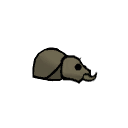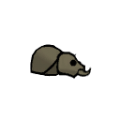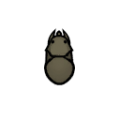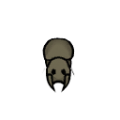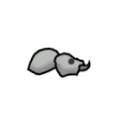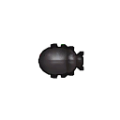Megascarab
Megascarab
A large, genetically-engineered beetle. Once the worker caste of an artificial ecosystem of insectoids designed to fight mechanoid invasions, it is now often seen without its deadlier insectoid cousins. Still, its size and hard shell make it dangerous when it attacks. A eusocial creature, it cannot reproduce individually.
Base Stats
Apparel
- Armor - Sharp
- 72%
- Armor - Blunt
- 18%
Pawn Stats
- Combat Power
- 40
- Move Speed
- 3.75 c/s
- Health Scale
- 0.4
- Body Size
- 0.2
- Mass - Baby
- 2.4 kg
- Mass - Juvenile
- 6 kg
- Mass - Adult
- 12 kg
- Carrying Capacity
- 15 kg
- Filth Rate
- 1
- Hunger Rate
- 0.16 Nutrition/Day
- Diet
- omnivorous, animal products
- Life Expectancy
- 10 years
- Manhunter Chance
- 50%
- Manhunter Chance (Taming)
- 0%
- Trainable Intelligence
- Intermediate
- Wildness
- 20%
- Minimum Handling Skill
- 1
- Maturity Age
- 0.4 years (24 days)
- Juvenile Age
- 0.03 years (1.8 days)
- Comfortable Temp Range
- 0 °C – 60 °C (32 °F – 140 °F)
Production
- Meat Yield
- 31 insect meat
Melee Combat
- Attack 1
- Mouth
5 dmg (Bite)
7 % AP
2 second cooldown - Attack 2
- Head
4 dmg (Blunt)
6 % AP
2 second cooldown
0.1 chance factor - Average DPS
- 1.4
- tradeTags
- AnimalInsect
Megascarabs are a type of Insectoid found in regular and extreme deserts, infestations or inside ancient shrines, including inside the caskets.
Summary[edit]
They are ground beetles of metallic color that posses elytra, a protective shell that provides some armor. Megascarabs are hazardous to hunt, for if they are injured by a human or a mechanoid, they will turn manhunter and attack any human or mechanoid on the map they can reach. If slain, they can be butchered for insect meat. Colonists dislike eating any insect meat, but meat-eating animals have no such problem.
All insectoids, including the megascarab, experience hypothermic slowdown instead of fatal hypothermia, have 100% Toxic Resistance, rendering them immune to toxic buildup from any source, and 80% Toxic Environment Resistance, rendering them resistant to environmental effects such as rot stink. They experience also pollution stimulus when in polluted terrain.![]() See that page for full details.
See that page for full details.
Insectoids are incapable of sexual reproduction like other animals, due to their breeding type (EusocialInsect). Instead, wild insects reproduce via hives which create new insectoids periodically, up to a maximum value each hive can support. Tamed insectoids cannot reproduce at all. For more detail, see the Hive page.
Armor[edit]
| Armor |
|---|
Analysis[edit]
Combat[edit]
Megascarabs are the smallest and fastest of the 3 insectoid types, and will often catch up to colonists and "lock" them into melee. It may be wiser to focus on bigger targets, like megaspiders, as they are stronger in combat.
Melee block tactics work well against infestations in general. In an open field, kiting works well, as even megascarabs are slower than a healthy human.
Taming[edit]
Megascarabs offer no real niche as a tamed pet, however they can be tamed. Unlike the larger insects, they can generate non-hostile, and are found naturally in deserts.
Training[edit]
This animal can be trained as follows:
| Guard: | |
|---|---|
| Attack: | |
| Rescue: | |
| Haul: | |
*As of version 1.1.2610, all animals can be tamed. The percentage of likelihood of success depends on factors such as the Animals Wildness Percentage, Pawn Handling Skill, and others. More information can be found on the animals page.
Health[edit]
Gallery[edit]
Version history[edit]
- Beta 19/1.0 - All insects main attack cooldowns 2.5 -> 2.9
- Some time between A6 and A13 - Sprite changed.
- 1.3 - Revenge on tame fail decreased from 20% to 10% - revenge on harm increased from 35% to 50% - wildness decreased from 95% to 20%.
- Biotech DLC release - Now gains pollution stimulus on polluted terrain.
